Menu

💧 Did you know drip irrigation can make water use better by up to 60%? With water becoming less available and affecting plant growth and farming by 2050, many garden lovers look to smarter ways to water. Drip irrigation, a clever watering method, gives plants just the amount they need. It does this well and without wasting water. This keeps the soil’s health in check by not over-watering and helping keep the soil’s oxygen levels right.
🌿 For someone who loves gardening, I see why it’s smart to use systems like drip irrigation. It can save money on water in the long run and make your plants grow more. Plus, by using low-pressure humidity, it lessens the chance of pests and plant diseases. With all these plus points, it’s clear why drip irrigation is a big deal for better garden watering.
Drip irrigation, also known as trickle irrigation, is a focused way to water plants. It sends water directly to the plants’ base. This means less water is wasted and plants get just the right amount they need for growth. Let’s look into how drip irrigation works, where it comes from, and what it uses.
Drip systems are precise, putting water where it’s needed, slowly, and directly into the soil. This method saves water, making it great for plants like onions, lettuces, melons, and tomatoes. It works at low pressure, ensuring water goes deep without messing up the topsoil.
Drip irrigation started long ago and has grown a lot. Now, we have modern tools to make it work better, like different drip tape sizes, letting us save water and grow more food. These systems can cost between $500 to $1,200 an acre but lead to using water better and more food being grown.
We need a few important parts for a drip irrigation system to work well:
It’s also important to use flow meters to watch how much water is used. For more hands-off watering, timers and smart systems can be added. These help keep watering regular and efficient.
Drip irrigation is very good at saving water. It’s about 90% effective, while other methods are only 65-75% good. This is better for the environment and for growing strong plants.
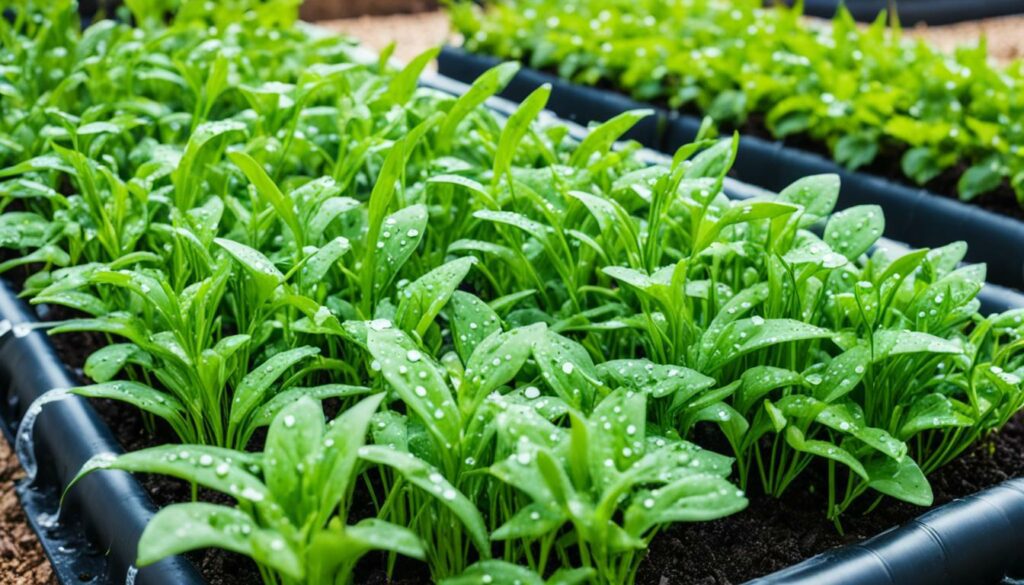
Drip irrigation systems change the way you look at garden care. They are great for saving water and helping plants grow better. Below, we’ll explore the top benefits of using drip irrigation for gardening.
Drip irrigation is all about saving water. It sends water straight to plant roots, reducing runoff and evaporation. This can save 30 to 50% more water than traditional methods. It’s key to keeping gardens sustainable.
This system provides plants with the exact water they need, avoiding overwatering. It keeps leaves dry, lowering disease risks and helping plants grow strong. Native plants and trees thrive, needing less water as they get older.
At first, drip irrigation might seem like a big expense. However, it can save up to 70% on water, paying for itself in one to two years. You’ll also spend less on utilities and fertilisers over time.
Drip irrigation is very versatile. It can work in many garden settings and with different plant types. These systems also reduce water use by cutting down on grassy areas. Watering at the right times avoids excess evaporation too.
| Benefit | Description | Percentage of Efficiency |
|---|---|---|
| Water Conservation | Uses 30-50% less water than traditional methods | 30-50% |
| Improved Plant Health | Delivers precise moisture, reducing disease risks | N/A |
| Cost Savings | Initial cost recouped in 1-2 seasons through water savings | Up to 70% |
| Versatility and Flexibility | Adapts to various landscapes, maximises water use | Varies |
To sum up, using drip irrigation helps protect water and makes sure your garden is healthy all year. Its advantages are clear, positioning it as a must-have for today’s gardeners.
Drip irrigation is a big change in making soil healthier. It works by using less water but keeping the soil moist. This method sends water right to the plant’s roots, helping them grow better and boosting crop production.
The special tools in drip systems keep soil moisture perfect all the time. This means less water is wasted, up to 50% less. Plants get the precise amount of water they need. This helps their roots grow stronger and deeper.
Using drip irrigation also keeps nutrients from washing away. Because water goes directly to the roots, nutrients stay in the soil. This helps plants use fertilisers better, keeps the soil rich, and helps good microbes thrive.
Traditional ways of watering can wash soil away. Drip irrigation, with its gentle water delivery, keeps the soil firm and fertile. It stops soil erosion and is good for saving water, which is important for the planet.
Below is a comparison of the advantages of drip irrigation over traditional irrigation methods:
| Aspect | Drip Irrigation | Traditional Irrigation |
|---|---|---|
| Water Usage | Reduces by up to 50% | High water wastage |
| Nutrient Leaching | Minimises leaching | High nutrient loss |
| Energy Efficiency | Lower pressure, less energy | Higher pressure, more energy |
| Soil Erosion | Prevents erosion | Significant runoff |
The positives of drip irrigation show why it’s getting more popular. It’s good for soil, saves water, and fits well with how we should use water in farming.
Drip irrigation makes a big difference in how well plants grow. It saves a lot of water and makes crops bigger. It waters each plant’s roots directly. This saves water and stops plants from getting sick.
Drip systems are great at making crops better. They can make potatoes grow more and help corn plant yields even in dry weather by 80%. They give water right where it’s needed, making plants grow a lot more.
Drip irrigation also helps plants stay healthy by reducing diseases. Water goes to the roots, not the leaves. This keeps plants from getting fungi and bacteria, especially important in gardens to keep plants strong and disease-free.
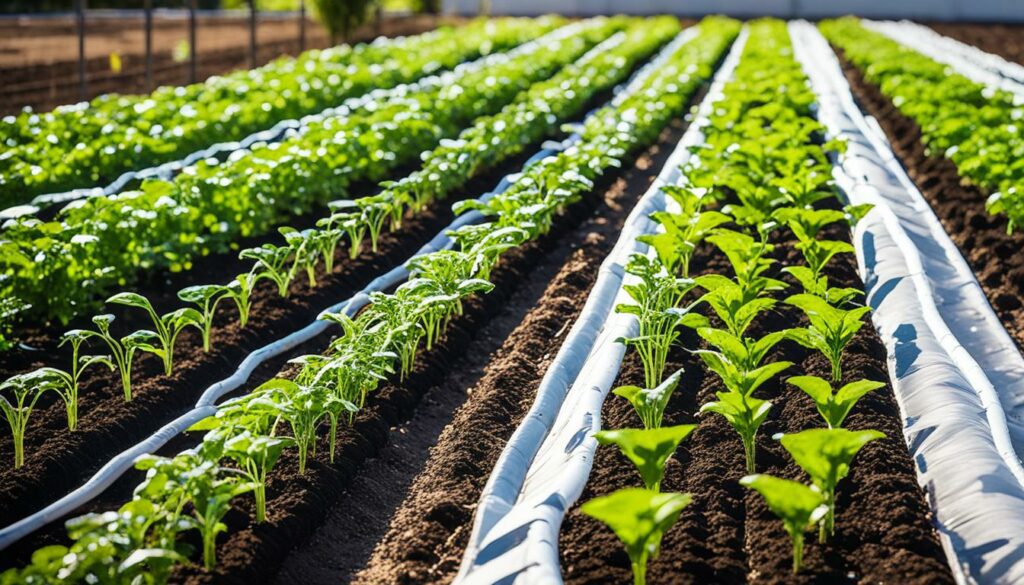
Drip irrigation is also perfect for making roots stronger. It gives the perfect amount of water to plants. This makes the roots grow deep and strong, helping plants survive tough times like droughts. So, using drip systems is a smart way to water plants.
Drip irrigation is super good with water, up to 90% better than other ways. This means it’s the best for watering plants properly, making them grow better and stay healthy.
| Benefit | Drip Irrigation | Traditional Irrigation |
|---|---|---|
| Water Efficiency | 90% | 65-75% |
| Crop Yield Increase | Up to 80% | 20-30% |
| Disease Reduction | Significant | Moderate |
Creating a drip irrigation system makes sure your plants get just the right amount of water. It uses simple tools and parts for automatic watering. This is ideal for any garden. Let’s see how to do it.
First, gather everything you need. A drip irrigation system requires:
Don’t forget to keep all your tools in a clear plastic bin. This helps you not lose anything during the setup.
Let’s now set up the drip irrigation system. Just follow these simple steps:
Here are some handy tips to make sure your drip system works well:
Setting up an automatic irrigation system smartly makes garden care a breeze. Your plants will always get just the right amount of water.
It’s key to follow best practices with your drip system for top-notch watering and a thriving garden. Stick to a plan and make tweaks where needed to get the most from your setup.
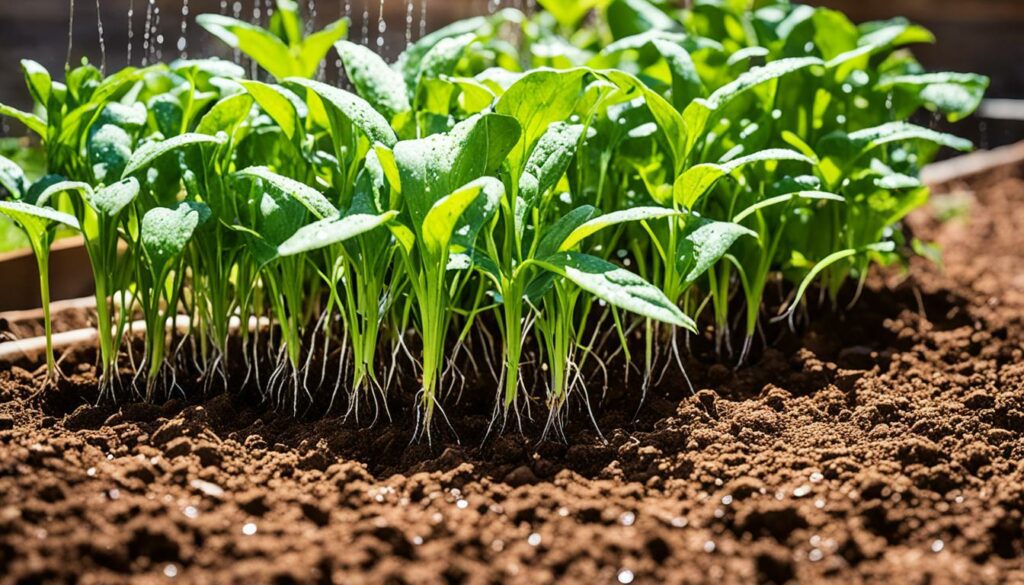
Getting your watering schedule right is vital. Timed systems are great for making sure plants get just what they need. This not only stops wasteful over-watering but helps save water too.
Keeping an eye on your system and giving it regular checks is a must. Look out for blockages, leaks, and any parts not working properly. A few simple tools can fix these issues, making sure your garden stays watered without interruptions. And, using a filter helps keep debris from causing problems.
Don’t forget to adjust your system to the season. Plants need more water in the heat and less when it’s cold. Putting mulch around your tubing can shield it from the sun and make it last longer. This keeps your drip system running smoothly, no matter the weather.
Following these steps not only makes for efficient watering and a lush garden. They also help keep your garden healthy and eco-friendly.
| Best Practices | Details |
|---|---|
| Scheduling Watering Times | Use timers for consistent and efficient watering to avoid water wastage. |
| Monitoring and Maintenance | Regular inspections and proper tools ensure the system functions optimally without clogs or leaks. |
| Seasonal Adjustments | Adjust watering frequency based on seasonal changes and plant needs. Protect tubing with mulch. |
Drip irrigation saves a lot of money because it uses water wisely. It’s very good at giving the right amount of water to plants. In fact, it can lower water use by up to 60% compared to older methods. This makes it perfect for saving water.
With a drip system, nearly all the water goes directly to the plants. This lets gardeners use their water and money more wisely.
Setting up a drip system costs between $300 to $800 for surface systems, and $1,000 to $4,000 for subsurface ones. Even though the start-up costs seem high, you save a lot in the long run. You can also change your old sprinklers into drip systems, which costs between $300 and $1,200 for each area.
Automated drip systems are also a great choice. They come with timers to control water and work costs. For big areas, they usually cost between $500 and $1,200 per acre. For homes, they are about $520 to $815. The time it takes to set them up changes based on your garden’s size and how complex it is.
Here’s a table that shows the costs and how much these systems save water:
| Component | Cost Range | Efficiency | Water Savings |
|---|---|---|---|
| Surface Drip System | $300 – $800 | 90% | 60% |
| Subsurface Drip System | $1,000 – $4,000 | 90% | 60% |
| Sprinkler System Conversion | $300 – $1,200 per zone | 90% | 60% |
| Automated Drip Systems | $500 – $1,200+ per acre | 90% | 60% |
It’s important to look after these systems well. They need clean water and regular checks to avoid problems. But, caring for them is worth it. They save a lot of money and do a great job, which is perfect for managing gardens well.
The drip system has changed how we water plants. It saves water and boosts plant health. By saving water, drip irrigation makes the most of what we have.
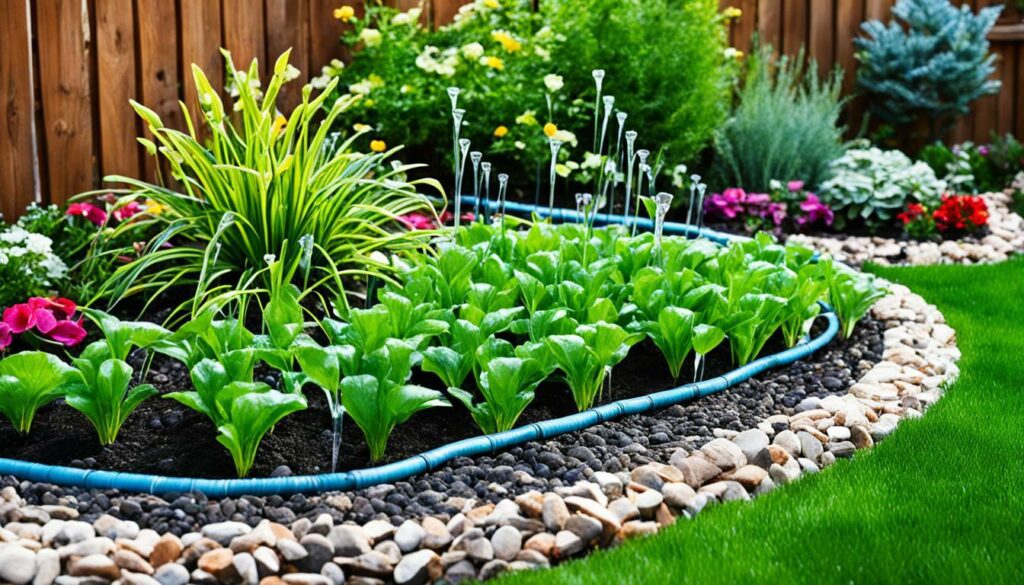
Drip systems are great at cutting down evaporation. They water plants’ roots directly. Doing this cuts down the water that disappears into the air.
Using drip irrigation early in the morning or late at night helps too. This uses water more wisely. In fact, drip systems are up to 90% better at using water than traditional sprinklers.
Preventing water from washing off the soil is a big win in drip irrigation. Other ways of watering often make water run off, especially on hills. This is a big water waster. Drip systems give water slowly. This means it soaks into the soil right where the plants need it, stopping any runoff.
Important tips for a better drip system:
These steps help the drip system save water and keep plants healthy.
Setting up an automatic irrigation system changes the game for garden lovers. It uses smart irrigation technologies to manage water distribution precisely and efficiently.
Adding timers to your drip irrigation makes water control easy and hands-free. They water plants at set times, cutting down water waste. This ensures the plants get their water when it’s most beneficial.
Advanced systems make your automatic irrigation even smarter. They adapt to soil moisture and the weather, adjusting water flow accordingly. This keeps your watering system efficient and promotes healthy plants.
Smart irrigation uses the internet to let you manage your watering system from anywhere. You can tweak watering in real-time and see detailed schedules. It gives you the right water amount, making everything more effective.
Automating with these technologies not only saves time but also makes your water use more efficient. This helps your garden thrive sustainably.
When looking into garden irrigation, choosing the right irrigation equipment is key. This ensures your plants grow well and saves water. Knowing the types of drip systems helps match one to your garden.
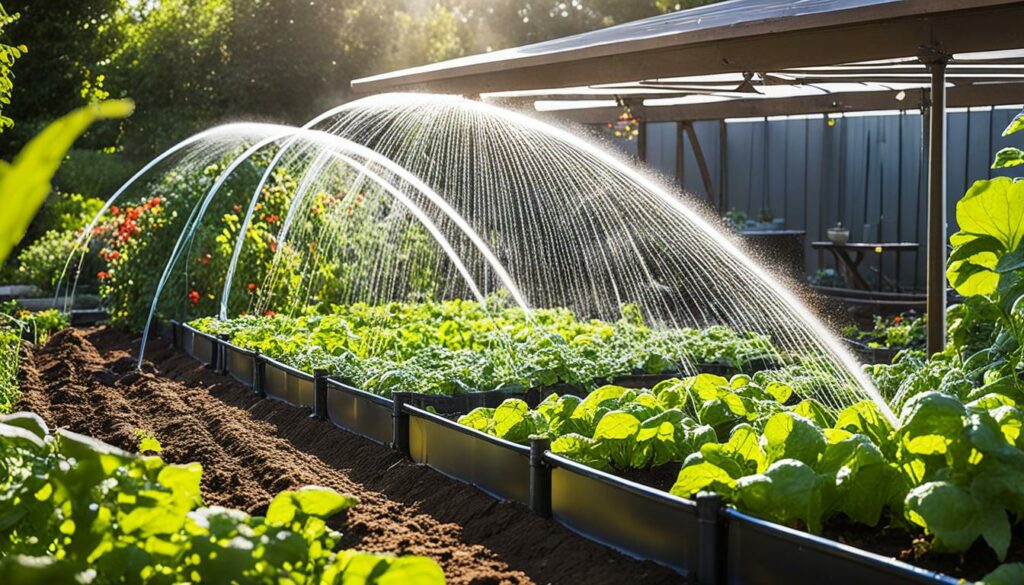
Four main types of drip irrigation systems exist:
Picking the right irrigation equipment can save time and water, helping your garden excel. But, some systems need careful setup and upkeep. For example, certain drips must be taken apart in winter to avoid damage from ice.
It’s crucial to think about how long each system lasts and what maintenance they need. Soaker hoses, for instance, last about 3 to 5 years. Plus, note that some systems might need water pumps or automatic features, based on your garden’s size and watering needs.
At first, drip irrigation might be more expensive than other methods. Yet, the savings in water and maintenance costs over time make it worthwhile. Assessing your garden’s unique needs helps find the best garden irrigation solution.
Starting your garden with drip irrigation means looking at what you already have. Then, see what needs to change to fit the new system. Doing this will save water and make your plants grow better.
First, look at your old watering setup. Find any parts that might not work well with a drip system. This could be old sprinklers or blocked water pipes. Noticing these issues early will make the switch easier.
When you move to drip irrigation, you add special lines and parts. How you place these parts depends on your soil type. This step helps you use water better. It’s good for the plants, too.
Here’s how drip irrigation measures in water use versus other methods:
| Irrigation Method | Efficiency |
|---|---|
| Drip Irrigation | Exceeds 90% |
| Sprinkler System | 50-70% |
Make sure to include filters in your system. They stop dirt and algae from blocking the waterways. Drip irrigation is good at saving water, which means smaller bills and happier plants. It’s a smart choice for your garden and the environment.
Drip irrigation systems are a top choice for those who care about the environment. They’re known for saving water and causing less harm to ecosystems. These systems use water very efficiently, reducing waste and lowering the impact of farming on our planet.
Drip irrigation is very efficient, using up to 90% less water. In contrast, sprinklers are only 65-75% efficient. This high efficiency helps water go straight to the plant roots, cutting out runoff and evaporation. By using drip systems, we can save up to 80% of water used by other means.
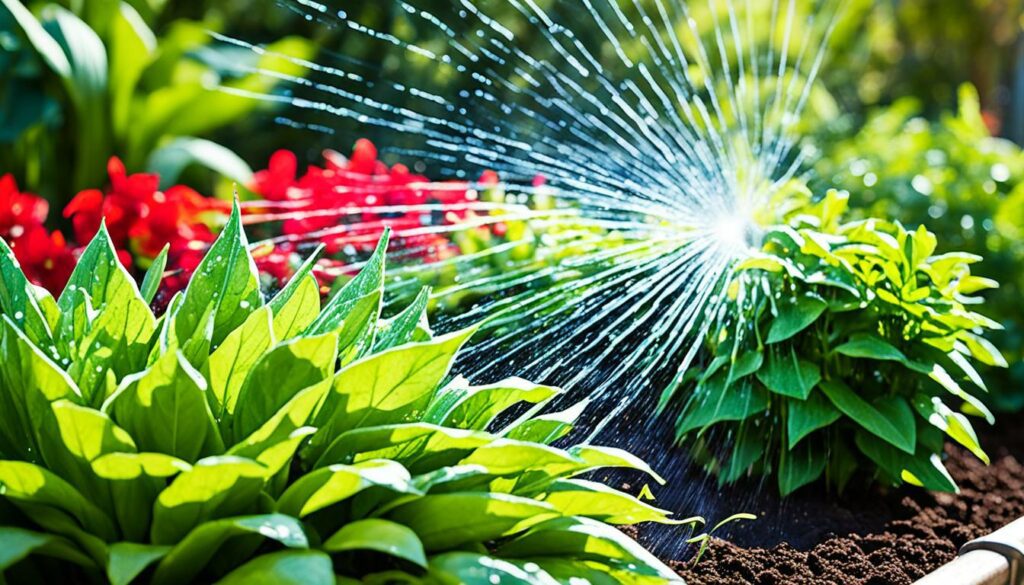
With drip systems, water and fertilizers are given only where needed. This helps plants to grow with fewer chemicals. Less water is wasted, and the risk of over-fertilizing is reduced. As a result, ecosystems stay healthier. Systems can also mix fertilizers into the water, using them more effectively and producing less waste.
Drip irrigation means less hard work and less energy used. It works on low pressure, unlike sprinkler systems that need more power. This can reduce energy use by half. There’s also less runoff and evaporation, making it a better choice for the environment. With these systems, we can look after our plants while being kind to the earth.
I’m really into making my garden water well with a drip system. I’ve solved many of the problems it can have like getting blocked, leaking, or not having the right pressure.
Clogged bits are a big issue. I use sand separators to stop most large bits from getting through. But I also clean the filters and change bits that are starting to fail to keep my system running well.
Water leaking is common, from the hoses and broken bits. By checking for leaks often, I can stop a lot of water wastage. If I find any issues, I fix them right away.
Keeping the water pressure steady is key too. I watch the pressure and adjust valves to get it right. In the cold months, draining the system helps it last longer, usually up to 10 years.
A good tip is to have a repair kit ready, like the one from DripWorks. It’s great for fixing leaks and changing parts that might break in older systems.
Also, keeping track of when and how much you water is smart. This helps in planning when to do maintenance. These steps make sure the system works well and is kind to the environment.
A well-designed drip system greatly boosts farm output. It does this by giving each crop the exact water amount it needs. Studies show up to a 30-50% cut in water use over old ways. This means more water for every plant, cutting waste. In the end, this careful approach can lift harvests by as much as 50%.
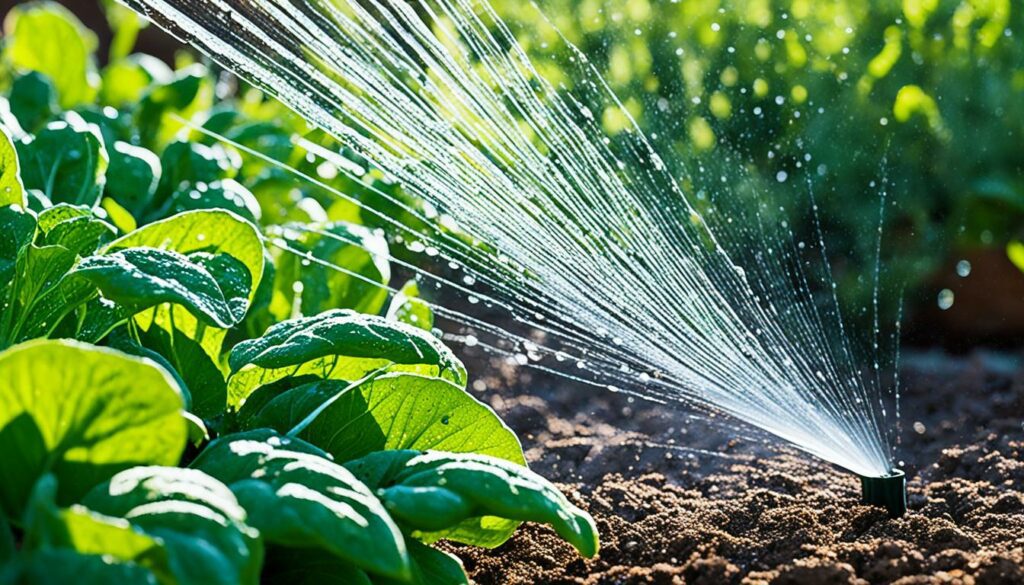
Getting water just where plants need it is key for a drip system. It goes to the roots straight, cutting water lost to air or ground. This smart use of water cuts energy needs by 60%. It’s great news for both the farm and the planet.
With drip irrigation, plants get their food just right. Using fertilisers efficiently stops too much getting into the soil or running off. This method can also slash the growth of weeds by 90%. That means the plants get more food and the farm stays more productive.
Watching how the plants are doing is very important. It means the drip system can be fine-tuned for the best results. Imagine, farmers can grow more crops using less water. This happens when they pay close attention to their crops’ needs.
| Benefit | Percentage Increase/Reduction |
|---|---|
| Water Saving | 30-50% reduction |
| Crop Yield Increase | Up to 50% |
| Weed Growth Reduction | Up to 90% |
| Soil Erosion Reduction | Up to 60% |
| Energy Consumption Reduction | Up to 60% |
| Labour Cost Reduction | Up to 50% |
Drip irrigation systems are extremely valuable in today’s agriculture and gardens. They use 70% less water than traditional methods, making them key in saving water. They work by watering plants directly and sparingly, so no water is wasted.
These systems have a big impact. In China, they raised wheat yields significantly and used water more efficiently. The same is seen around the world for crops like fruits and vegetables. They can boost productivity up to two-thirds while saving water by more than half.
Not only are drip systems good for the planet, but they save money too. At Lewis University, they found that these systems can save a lot of money on water, especially for large areas. They also help plants grow better and use fewer pesticides, helping the environment.
Today, there’s a lot of research showing how great drip irrigation is. Places like China and the U.S. are using it to change the way they farm. It helps us use resources wisely, keep plants healthy, and manage water better. Drip irrigation is the way to go for a sustainable future in gardening and farming.
Drip irrigation, or trickle irrigation, is a system. It waters plants directly at their base. This controlled method stops water wastage and overwatering.
Drip systems have many parts. There’s the water source, backflow preventers, filters, and more. All these work together to water plants automatically.
Drip systems drop water right to the plant’s roots. They save up to 70% of water. That’s a big win for water-saving efforts.
Drip irrigation keeps leaves dry, which helps avoid diseases. It also gives roots constant moisture. This leads to the best use of nutrients for the plants.
These systems reduce water use, which cuts water bills. They also need less manual labour and lower fertiliser costs. So, they’re a smart choice for saving money in gardens.
They keep soil moisture at the right level. This prevents nutrients from washing away. Soil erosion is less likely. All this makes a great place for plants to grow.
Drip systems can boost crop yields better than usual methods. They save water and enhance production. This is especially true in dry areas.
You need basic supplies like tubing, emitters, and connectors. Also, a pressure regulator, filter, and control system are key for effective watering.
Schedule watering for your plants’ needs. Keep an eye on the system and update it as seasons change. This way, the system will always support plant growth.
Drip systems water directly and at cooler times. This curbs water loss by evaporation. Also, they’re so precise that water run-off isn’t an issue.
Timers and smart control systems ensure water is delivered evenly. They also adjust to the weather, making watering efficient and keeping plants healthy.
Think about your garden’s size, the plants you have, and their water needs. Choosing the right system lets you water each plant as it needs for health.
Check your garden’s current setup, and plan how to switch to drip. This may need updating old parts. Drip systems save water and benefit plant health.
Drip irrigation uses water and fertiliser efficiently. This cuts down waste and the use of harmful chemicals. It stands for sustainable, eco-friendly gardening.
Clogging, leaks, and uneven water pressure are common issues. Check the system often, clean the filters, and balance water flow. This ensures your plants are always well-watered.
Keep a close watch on water, use fertiliser well, and check on plant health. This active management makes your drip system highly effective. It saves water and grows healthy plants.